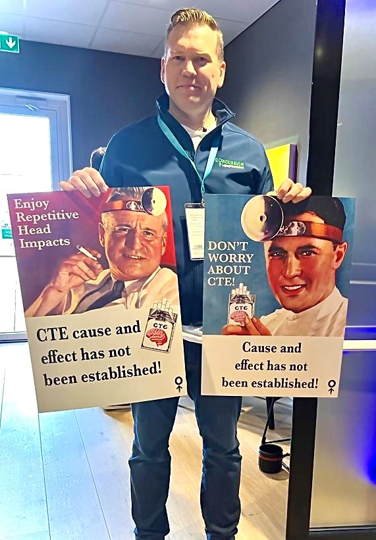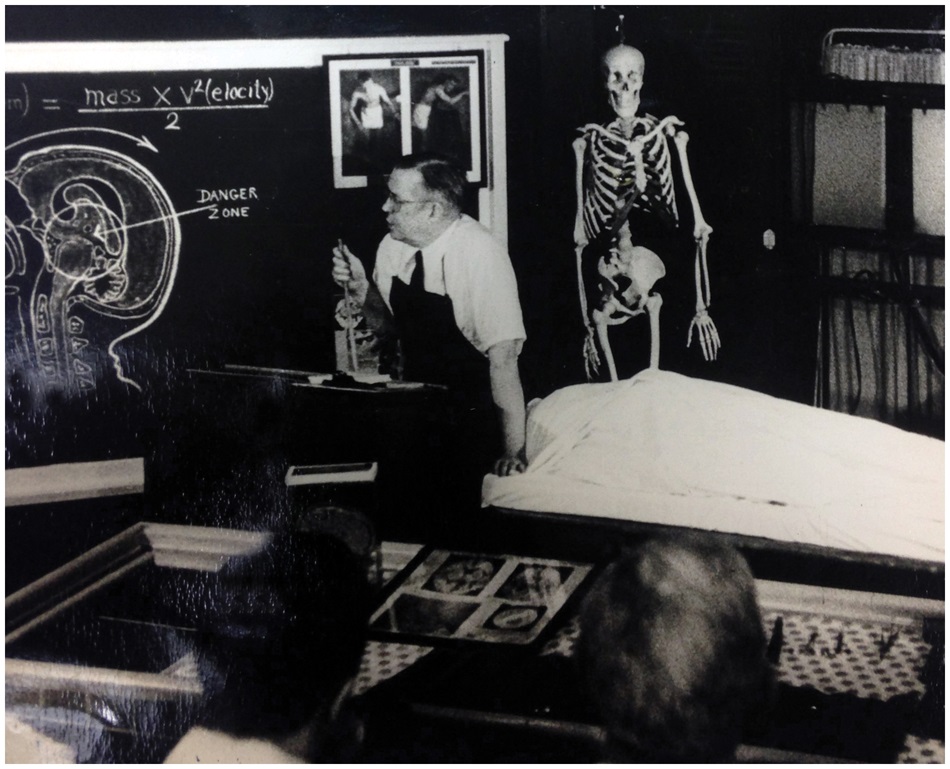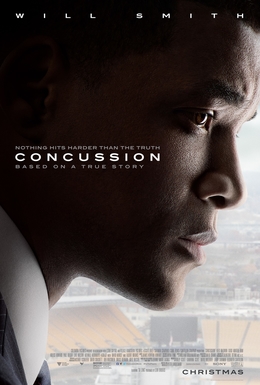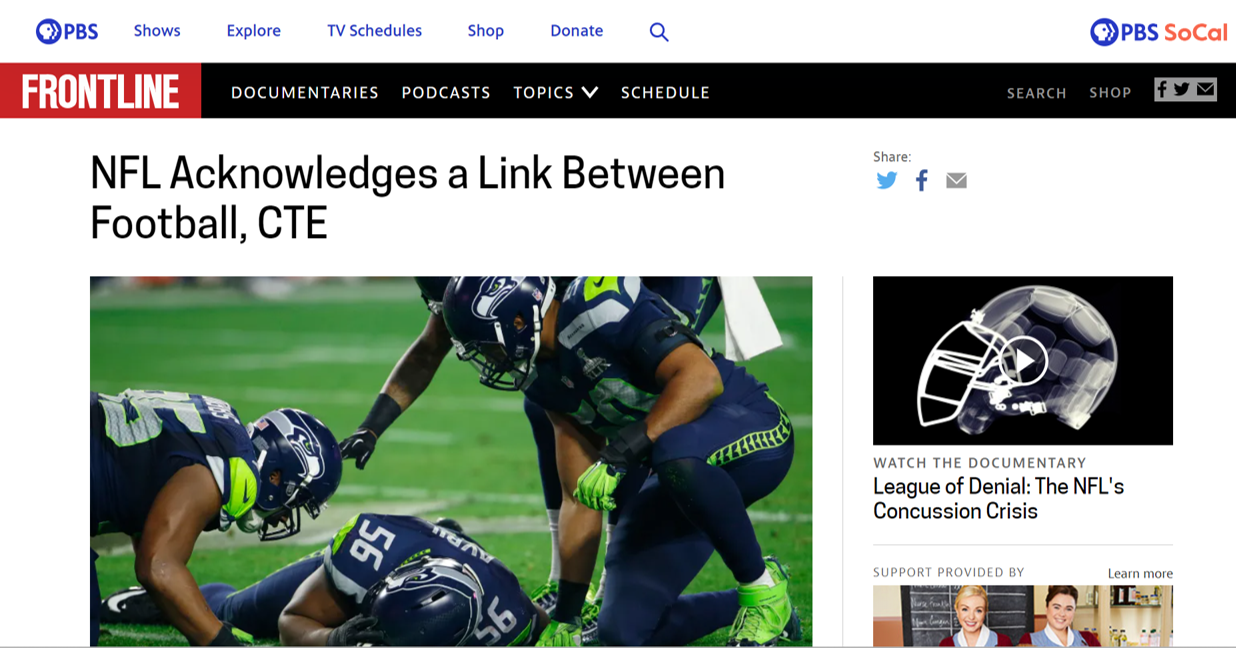- CTE is a real disease
- CTE is the same clinical syndrome that was originally termed ‘punch drunk’ for over a century
- Recently repetitive head injury has enough evidence to be considered a cause of CTE
- RHI however, is not a 100% guarantee one will develop the clinical symptoms associated with CTE
History
Despite what one neuropsychiatrist argues,7 CTE is a real disease. What many, including some media pundits, don’t fully understand is that currently its diagnosis can only definitively be made by an autopsy. The reason for this is currently CTE is still a pathological diagnosis, that is a disease of the brain seen and diagnosed under the microscope.8,9,10
CTE is defined by the type of protein, termed p-tau, that aggregates into specific locations and specific types of cells in the brain.11,12 When this protein and its various sub-types aggregate in other distinct parts and distinct cells of the brain, other neurological syndromes like Alzheimer’s disease, progressive supranuclear palsy, aging-related tau astrogliopathy, and the list goes on, occur and while they have similar symptoms, what makes them different is the final microscopic pattern (i.e. pathology) as well as the risk factors associated with their development. This is why currently CTE cannot be definitively diagnosed and differentiated from other causes of dementia and/or mood disturbances without an autopsy.
While studies are underway to determine if there’s a way to provide a definitive diagnosis of CTE while someone is alive, currently one can only receive a probable diagnosis without an autopsy and even then it’s recommended this only be done in one of the aforementioned clinical studies. Currently, if one does receive a probable diagnosis while alive, it is actually termed ‘traumatic encephalopathy syndrome’ (TES).13 The current proposed symptoms of TES that have been associated with CTE are a progressive (meaning they continue to worsen as time goes on) march of mild to severe mood disorders and/or mild to severe dementia. What’s interesting is not everyone who has officially diagnosed CTE (again, this is by autopsy) had clinical symptoms of TES prior to death, so even if one is exposed to head injuries and has the lesions that define the disease it’s not a sure fact they will develop clinical symptoms.8,9,13 So what causes CTE and what leads to increased risk of developing TES?
This is where repetitive head injury (RHI), both minor and severe, and the sports that have a high risk of exposure to RHI, enter the story. Despite the syndrome being published on since the early 1900s, it hasn’t been until the last twenty years that research has boomed. Multiple retrospective case studies and case-control studies show that TES and/or CTE exist in a HUGELY higher proportion of people with history of RHI compared to those without.10,14,15,16,17,18,20 Additionally, prospective animal model studies show inflicted closed head trauma does induce the production of the p-tau protein compared to those who don’t have trauma, arguing that the abnormal protein is produced in a response to head trauma.19 More impressive however is there now exists enough research that as of July of this year, using the Bradford Hill Criteria for Causation (the same criteria used to show cigarette smoke is a cause of lung cancer), scientists can state with high certainty that RHI is a cause of CTE.10 This has led to the recently released official statement by the National Institutes of Health that RHI is a cause of CTE on October 5th, 2022.
In summary, the current evidence does show that RHI is extremely likely the cause of CTE. What’s not known, and where more research is currently underway, is how to determine the diagnosis of CTE while someone is alive and why some people with CTE will develop clinical symptoms and some don’t (which by the way is similar to other neurological dementia syndromes like Alzheimer’s disease).10
CTE as a disease is debated not only in online comment sections but also in the scientific medical community.7,21,22 Prior to the release of the Bradford Hill criteria mentioned previously, RHI as a cause for CTE has been hotly debated but additionally there remains a small subsect of scientists who have been termed CTE denialists by some.7,8 Some will still argue that in order to definitively answer causation rather than just association, a prospective randomized trial would need to be done that randomizes people to having RHI inflicted versus not; and as you could imagine, this would be highly controversial as it would be a completely unethical study to perform especially with what we know already about the risks of RHI. Just as unethical as it would be these days to purposefully randomize non-smokers to smoking and not smoking cigarettes and see which group gets more cases of lung cancer.
It is true that just because someone has one or more small or large traumatic brain injuries it is not a guarantee they will develop clinical symptoms of CTE prior to death. That said, I submit that anyone who argues RHI should not be a concern when thinking about future risk of neurological disease has some alternative motive to deny or misinterpret the facts or ague their own truth, whether it be financial, personal, cultural, etc. A poignant summary (see the quote on the right) of the last century and the organizations that opposed supporting a link between RHI and CTE was made by Nowinski et al.10
While at least one of these organizations, the NFL, has changed its stance, some still have not.
“In the 20th century, a causal relationship was widely accepted by the public and punch drunk boxers became common characters in literature, television, and film … However, in recent years, some have begun to publicly question whether the relationship between RHI and CTE is truly one of causation. The modern RHI/CTE debate began with the diagnosis of CTE in an American football player in 2005. Prior to this case study, there appears to be no record of organizations like the National Football League (NFL), National Hockey League (NHL), or National Collegiate Athletic Association (NCAA) taking a public position against RHI/CTE causation. After 2005, all three leagues, and many others, went on record denying a link between RHI and CTE.”
Why so much debate?
CTE as a disease is debated not only in online comment sections but also in the scientific medical community.7,21,22 Prior to the release of the Bradford Hill criteria mentioned previously, RHI as a cause for CTE has been hotly debated but additionally there remains a small subsect of scientists who have been termed CTE denialists by some.7,8 Some will still argue that in order to definitively answer causation rather than just association, a prospective randomized trial would need to be done that randomizes people to having RHI inflicted versus not; and as you could imagine, this would be highly controversial as it would be a completely unethical study to perform especially with what we know already about the risks of RHI. Just as unethical as it would be these days to purposefully randomize non-smokers to smoking and not smoking cigarettes and see which group gets more cases of lung cancer.
It is true that just because someone has one or more small or large traumatic brain injuries it is not a guarantee they will develop clinical symptoms of CTE prior to death. That said, I submit that anyone who argues RHI should not be a concern when thinking about future risk of neurological disease has some alternative motive to deny or misinterpret the facts or ague their own truth, whether it be financial, personal, cultural, etc. A poignant summary of the last century and the organizations that opposed supporting a link between RHI and CTE was made by Nowinski et al.10
“In the 20th century, a causal relationship was widely accepted by the public and punch drunk boxers became common characters in literature, television, and film … However, in recent years, some have begun to publicly question whether the relationship between RHI and CTE is truly one of causation. The modern RHI/CTE debate began with the diagnosis of CTE in an American football player in 2005. Prior to this case study, there appears to be no record of organizations like the National Football League (NFL), National Hockey League (NHL), or National Collegiate Athletic Association (NCAA) taking a public position against RHI/CTE causation. After 2005, all three leagues, and many others, went on record denying a link between RHI and CTE.”
While at least one of these organizations, the NFL, has changed its stance, some still have not.
Conclusion
As with many progressive dementia illnesses, at this point there is no cure for CTE. Currently we only have treatments focused on supporting and managing the symptoms with behavioral and medicinal therapies. I’ll be honest, at times I feel like I live a double life as a physician who is passionate about helping people live healthy lives and prevent major illness but who simultaneously also loves sports that have a high incidence of repetitive head injury. I don’t (and won’t) deny or try to hide the facts, but I reconcile this dichotomy as many in my situation do; that is supporting the notion of individual choice and informed consent. So in conclusion I’d like to leave you with some burning and popularly debated questions:
- How informed are most athletes regarding the risks of repetitive head injury?
- How should we approach this for those that aren’t capable yet of providing consent, such as our children?
- What does it say about us as a society when we idolize athletes and veterans for what they do in their respective fields but then change our views when they become punch drunk?
References
- Omalu BI, DeKosky ST, Minster RL, Kamboh MI, Hamilton RL, Wecht CH. Chronic traumatic encephalopathy in a National Football League player. Neurosurgery. 2005 Jul;57(1):128-34; discussion 128-34. doi: 10.1227/01.neu.0000163407.92769.ed. PMID: 15987548.
- Martland HS. Punch Drunk. 1928;91(15):1103–1107. doi:10.1001/jama.1928.02700150029009
- Parker HL. Traumatic Encephalopathy (`Punch Drunk’) of Professional Pugilists. J Neurol Psychopathol. 1934 Jul;15(57):20-8. doi: 10.1136/jnnp.s1-15.57.20. PMID: 21610785.
- Brandenburg W, Hallervorden J. Dementia pugilistica mit anatomischem Befund. Virchows Arch Pathol Anat Physiol Klin Med. 1954;325(6):680-709. German. doi: 10.1007/BF00955101.
- Critchley M. Medical aspects of boxing, particularly from a neurological standpoint. Br Med J. 1957 Feb 16;1(5015):357-62. doi: 10.1136/bmj.1.5015.357. PMID: 13396257.
- Changa AR, Vietrogoski RA, Carmel PW. Dr Harrison Martland and the history of punch drunk syndrome. Brain. 2018 Jan 1;141(1):318-321. doi: 10.1093/brain/awx349. PMID: 29325051.
- Randolph C. Chronic traumatic encephalopathy is not a real disease. Arch Clin Neuropsychol. 2018 Aug 1;33(5):644-648. doi: 10.1093/arclin/acy063. PMID: 30169776.
- Buckland ME, Affleck AJ, Pearce AJ, Suter CM. Chronic Traumatic Encephalopathy as a Preventable Environmental Disease. Front Neurol. 2022 Jun 13;13:880905. doi: 10.3389/fneur.2022.880905. PMID: 35769361.
- Stern RA, Daneshvar DH, Baugh CM, Seichepine DR, Montenigro PH, Riley DO, Fritts NG, Stamm JM, Robbins CA, McHale L, Simkin I, Stein TD, Alvarez VE, Goldstein LE, Budson AE, Kowall NW, Nowinski CJ, Cantu RC, McKee AC. Clinical presentation of chronic traumatic encephalopathy. Neurology. 2013 Sep 24;81(13):1122-9. doi: 10.1212/WNL.0b013e3182a55f7f. Epub 2013 Aug 21. PMID: 23966253.
- Nowinski CJ, Bureau SC, Buckland ME, Curtis MA, Daneshvar DH, Faull RLM, Grinberg LT, Hill-Yardin EL, Murray HC, Pearce AJ, Suter CM, White AJ, Finkel AM, Cantu RC. Applying the Bradford Hill Criteria for Causation to Repetitive Head Impacts and Chronic Traumatic Encephalopathy. Front Neurol. 2022 Jul 22;13:938163. doi: 10.3389/fneur.2022.938163. PMID: 35937061.
- Bieniek KF, Cairns NJ, Crary JF, Dickson DW, Folkerth RD, Keene CD, Litvan I, Perl DP, Stein TD, Vonsattel JP, Stewart W, Dams-O’Connor K, Gordon WA, Tripodis Y, Alvarez VE, Mez J, Alosco ML, McKee AC; TBI/CTE Research Group. The Second NINDS/NIBIB Consensus Meeting to Define Neuropathological Criteria for the Diagnosis of Chronic Traumatic Encephalopathy. J Neuropathol Exp Neurol. 2021 Feb 22;80(3):210-219. doi: 10.1093/jnen/nlab001. PMID: 33611507.
- McKee AC, Stein TD, Crary JF, Bieniek KF, Cantu RC, Kovacs GG. Practical Considerations in the Diagnosis of Mild Chronic Traumatic Encephalopathy and Distinction From Age-Related Tau Astrogliopathy. J Neuropathol Exp Neurol. 2020 Aug 1;79(8):921-924. doi: 10.1093/jnen/nlaa047. PMID: 32688381.
- Katz et al. NINDS Consensus Diagnostic Criteria for Traumatic Encephalopathy Syndrome. Neurology May 2021, 96 (18) 848-863; DOI: 10.1212/WNL.0000000000011850
- Mez J, Daneshvar DH, Kiernan PT, Abdolmohammadi B, Alvarez VE, Huber BR, Alosco ML, Solomon TM, Nowinski CJ, McHale L, Cormier KA, Kubilus CA, Martin BM, Murphy L, Baugh CM, Montenigro PH, Chaisson CE, Tripodis Y, Kowall NW, Weuve J, McClean MD, Cantu RC, Goldstein LE, Katz DI, Stern RA, Stein TD, McKee AC. Clinicopathological Evaluation of Chronic Traumatic Encephalopathy in Players of American Football. JAMA. 2017 Jul 25;318(4):360-370. doi: 10.1001/jama.2017.8334. PMID: 28742910.
- Noy S, Krawitz S, Del Bigio MR. Chronic Traumatic Encephalopathy-Like Abnormalities in a Routine Neuropathology Service. J Neuropathol Exp Neurol. 2016 Dec 1;75(12):1145-1154. doi: 10.1093/jnen/nlw092. PMID: 27815395.
- Mackay DF, Russell ER, Stewart K, MacLean JA, Pell JP, Stewart W. Neurodegenerative Disease Mortality among Former Professional Soccer Players. N Engl J Med. 2019 Nov 7;381(19):1801-1808. doi: 10.1056/NEJMoa1908483. Epub 2019 Oct 21. PMID: 31633894.
- Russell ER, Mackay DF, Stewart K, MacLean JA, Pell JP, Stewart W. Association of Field Position and Career Length With Risk of Neurodegenerative Disease in Male Former Professional Soccer Players. JAMA Neurol. 2021 Sep 1;78(9):1057-1063. doi: 10.1001/jamaneurol.2021.2403. PMID: 34338724.
- Baron SL, Hein MJ, Lehman E, Gersic CM. Body mass index, playing position, race, and the cardiovascular mortality of retired professional football players. Am J Cardiol. 2012 Mar 15;109(6):889-96. doi: 10.1016/j.amjcard.2011.10.050. Epub 2012 Jan 30. PMID: 22284915.
- Genis L, Chen Y, Shohami E, Michaelson DM. Tau hyperphosphorylation in apolipoprotein E-deficient and control mice after closed head injury. J Neurosci Res. 2000 May 15;60(4):559-64. doi: 10.1002/(SICI)1097-4547(20000515)60:4<559::AID-JNR15>3.0.CO;2-K. PMID: 10797559.
- Lehman EJ, Hein MJ, Baron SL, Gersic CM. Neurodegenerative causes of death among retired National Football League players. Neurology. 2012 Nov 6;79(19):1970-4. doi: 10.1212/WNL.0b013e31826daf50. Epub 2012 Sep 5. PMID: 22955124.
- LoBue C, Schaffert J, Cullum CM. Chronic traumatic encephalopathy: understanding the facts and debate. Curr Opin Psychiatry. 2020 Mar;33(2):130-135. doi: 10.1097/YCO.0000000000000580. PMID: 31895156.
- LoBue C, Cullum CM. POINT/COUNTER-POINT-Beyond the headlines: the actual evidence that traumatic brain injury is a risk factor for later-in-life dementia. Arch Clin Neuropsychol. 2020 Feb 20;35(2):123-127. doi: 10.1093/arclin/acz074. PMID: 31867615.
- Figure 1 used with permission from Christopher Nowinshi, PhD, source was his Twitter account.
- Figure 2 from the Special Collections in the History of Medicine of the George F. Smith Library of the Health Sciences in Newark, NJ. https://www.libraries.rutgers.edu/health-sciences/visit-study/special-collections-history-medicine
- Figure 3 from the movie Concussion poster ad found accessible online.
- Figure 4 available under Creative Commons at https://commons.wikimedia.org/wiki/File:Chronic_Traumatic_Encephalopathy.png
- Figures 5 and 6 are screenshots of non-pay wall PBS web pages used as example only.








Recent Comments